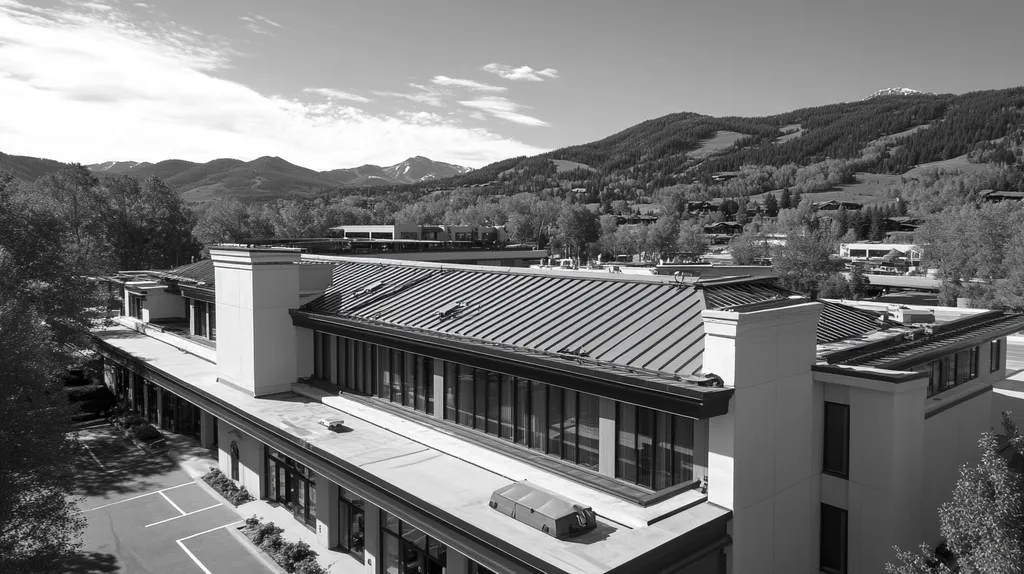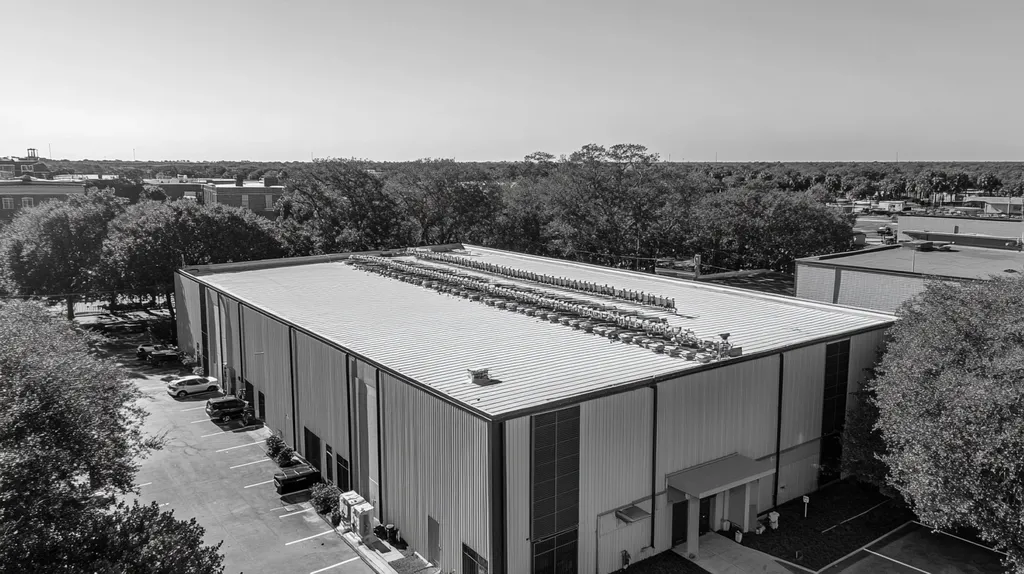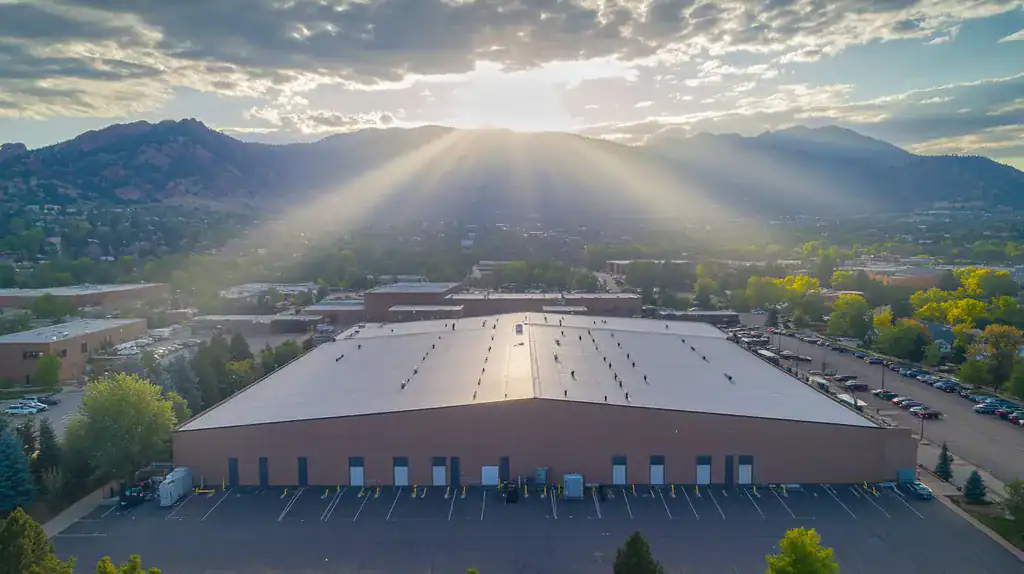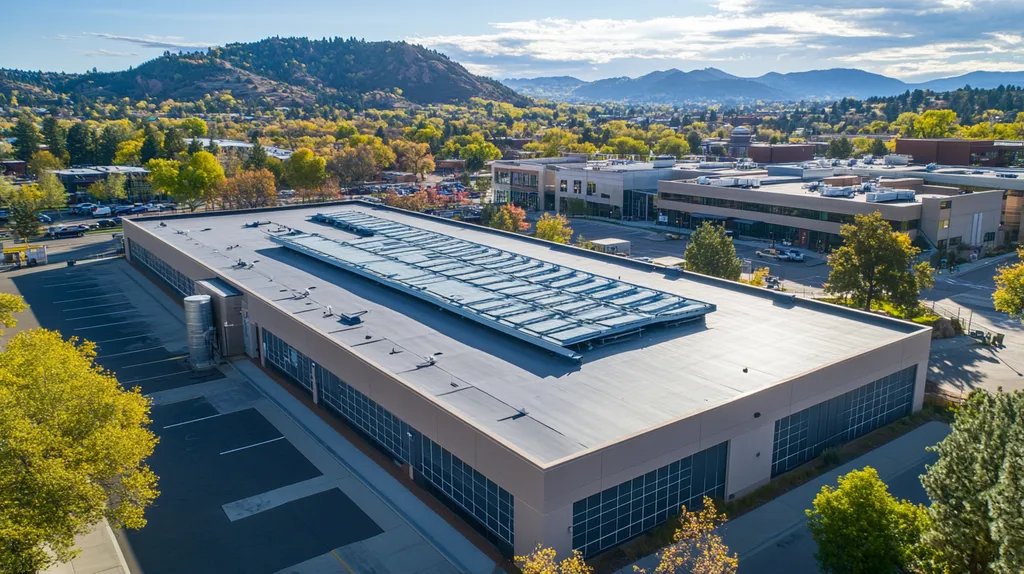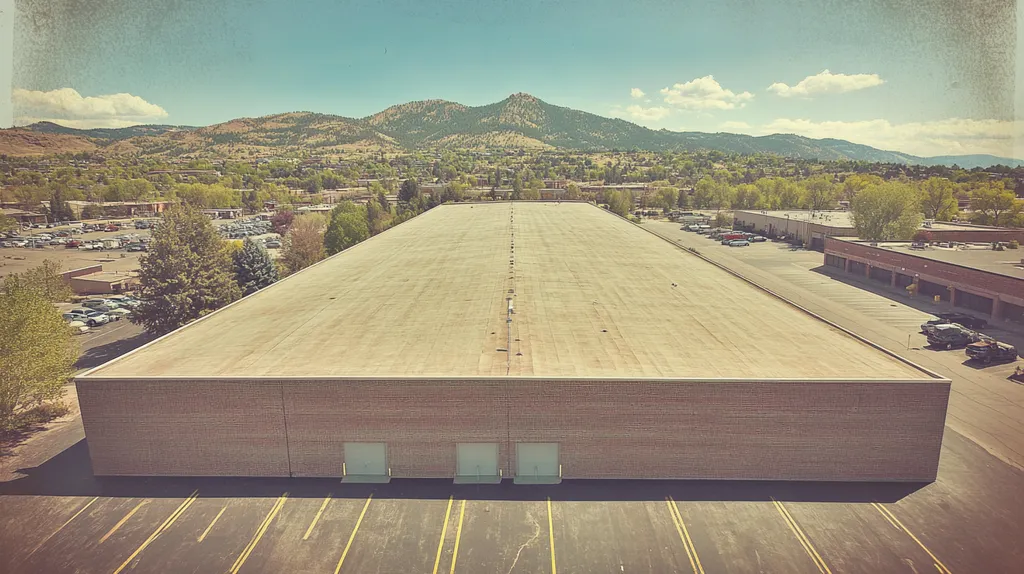Every year, severe storms cause over $3 billion in commercial roof damage across North America, with 40% of affected buildings experiencing significant business interruption.
When disaster strikes, the difference between minor repairs and catastrophic failure often comes down to response time and repair methodology.
This comprehensive guide equips facility managers and property owners with proven protocols for post-storm roof assessment, repair implementation, and long-term damage prevention, drawing from decades of commercial roofing experience and current industry best practices.
SECTION 1: FUNDAMENTAL CONCEPTS
When severe storms strike commercial properties, the roof often bears the brunt of nature’s fury. Each year, commercial roof damage from storms results in billions of dollars in repairs and business interruption costs. Understanding storm damage patterns, conducting proper assessments, and responding quickly can mean the difference between a minor repair and a catastrophic failure that threatens both building integrity and business continuity.
Types of Storm Damage in Commercial Roofing
High winds pose the most immediate threat to commercial roofs, capable of lifting and tearing roofing membranes, displacing ballast, and compromising edge metal systems. Wind-driven projectiles can puncture roofing surfaces, creating entry points for water infiltration.
Hail impacts present another significant challenge, potentially cracking or denting rigid roofing materials while creating countless impact points that weaken membrane systems. These weakened areas often develop into leaks months after the initial storm event.
Heavy rainfall tests the roof’s drainage capacity, with blocked drains or scuppers leading to ponding water. The weight of accumulated water can stress structural components while finding any available path into the building envelope.
Lightning strikes, though less common, can create both visible punctures and hidden damage to roofing systems. The extreme heat can melt materials and create pathways for moisture intrusion that aren’t immediately apparent.
Process for Post-Storm Roof Assessment
Initial assessment begins with a thorough exterior inspection from ground level, looking for obvious signs of damage such as displaced materials, ponding water, or debris accumulation. This preliminary survey helps identify areas requiring closer examination.
A qualified inspector must then conduct a detailed roof-level examination, systematically documenting all damage through photographs and detailed notes. Special attention focuses on penetrations, flashings, and drainage systems where failures commonly occur.
Core samples may be necessary in cases where moisture infiltration is suspected but not visible. These samples provide crucial information about the condition of underlying insulation and deck materials.
Modern assessment tools like infrared scanning can detect hidden moisture patterns, while drone technology enables safe inspection of hard-to-reach areas. These technologies provide comprehensive documentation critical for insurance claims and repair planning.
Key Risks from Delayed Storm Damage Response
Water infiltration represents the most immediate risk of delayed response, potentially damaging inventory, equipment, and interior finishes within hours of a breach. Even minor leaks can lead to significant complications if left unaddressed.
Structural deterioration accelerates when moisture penetrates the building envelope. Steel deck corrosion, rotting wood components, and weakened fastening systems can compromise the entire roofing assembly.
Mold growth begins within 24-48 hours of moisture exposure, creating health risks for building occupants and requiring costly remediation procedures. This biological contamination often extends far beyond the original leak location.
Insurance coverage may be jeopardized by delayed reporting or failure to take reasonable precautions after storm damage. Most policies require prompt notification and mitigation efforts to maintain coverage for both initial damage and subsequent losses.
SECTION 2: SYSTEM COMPONENTS
Commercial roofing systems represent significant capital investments that face constant environmental challenges. Understanding these components is crucial for effective post-storm response and long-term building protection. Each element must work in harmony to maintain structural integrity, with proper maintenance being the key to preventing catastrophic failures.
Roofing Membrane Materials and Vulnerabilities
Modern commercial roofing membranes come in three primary categories: thermoplastics (TPO and PVC), thermosets (EPDM), and modified bitumen. Each material responds differently to storm conditions and requires specific inspection protocols.
TPO and PVC membranes excel in reflecting UV radiation but can become brittle at seam points after prolonged exposure. These materials typically show damage through punctures, tears, or separation at weld points.
EPDM systems offer excellent durability but are particularly vulnerable to damage from wind-driven debris and hail impacts. Age-related shrinkage can create tension at perimeter attachment points.
Modified bitumen systems provide robust protection but can experience blistering and delamination after severe temperature fluctuations. Regular maintenance helps identify these issues before they compromise the entire system.
Common Flashing and Penetration Points
Flashing systems protect the most vulnerable areas of commercial roofs, particularly at transitions and terminations. These components require careful inspection after storms, as they’re often the first points of failure.
Roof penetrations for HVAC units, vents, and utility lines create natural weak points in the roofing system. Storm damage frequently occurs around these features first, making them priority inspection areas.
Metal copings and edge details demand particular attention, as wind uplift forces concentrate at roof perimeters. Loose or damaged edge metal can compromise the entire roofing system within hours.
Expansion joints and control joints must maintain flexibility while preventing water intrusion. Storm events can stress these components beyond their design limits.
Drainage Systems and Weatherproofing Features
Proper drainage remains critical to roof performance during and after storms. Regular inspections and maintenance of roof systems significantly impact building integrity and longevity. (source: National Clearinghouse for Educational Facilities)
Internal drains require clear paths to prevent ponding water. Even minor debris accumulation can lead to significant weight loading during heavy rainfall.
Scuppers and overflow drains serve as critical backup systems when primary drainage becomes overwhelmed. These secondary systems must remain unobstructed to prevent catastrophic ponding.
Tapered insulation systems and cricket designs direct water flow to appropriate discharge points. Storm damage can alter these slope patterns, requiring prompt assessment and repair.
SECTION 3: IMPLEMENTATION METHODS
Storm damage to commercial roofs creates immediate risks that demand swift, strategic response. Every hour of delay compounds potential damage, with water infiltration capable of compromising structural integrity, damaging inventory, and disrupting business operations. Understanding proper implementation methods can mean the difference between a quick recovery and prolonged disruption that impacts both property value and business continuity.
Immediate Steps After Storm Damage Detection
Initial response begins with a rapid yet thorough site assessment. Property managers should secure the affected area, restrict roof access to essential personnel only, and document all visible damage through photographs and detailed notes.
Emergency stabilization measures must be implemented to prevent further damage. This includes deploying temporary covering systems, establishing water diversion channels, and removing debris that could cause additional harm during subsequent weather events.
Proper notification procedures should be followed, including contacting insurance providers, documenting all communication, and engaging qualified roofing professionals. Time-stamped photographs and written records create a clear timeline of response efforts.
Building occupants must be informed about potential risks and any necessary operational adjustments. Clear communication helps maintain safety while managing expectations during the repair process.
Repair vs. Restoration Decision Criteria
Evaluation of damage extent forms the foundation of the repair strategy. Isolated damage affecting less than 25% of the roof surface typically indicates repair as the most cost-effective solution.
The roof’s age and existing condition play crucial roles in decision-making. Systems nearing the end of their service life may warrant full restoration, even if storm damage appears limited.
Budget considerations must balance immediate costs against long-term value. While repairs offer quick solutions, restoration can reset the lifecycle clock and provide enhanced protection against future storms.
Technical feasibility assessment determines whether repairs can maintain system integrity. Factors include material compatibility, warranty requirements, and code compliance.
Best Practices for Safe and Effective Repairs
Safety protocols must be established before work begins. This includes setting up fall protection systems, identifying hazard zones, and implementing proper personal protective equipment requirements.
Material selection should prioritize compatibility with existing systems. Using manufacturer-approved materials ensures proper adhesion, maintains warranties, and provides consistent performance.
Quality control measures require systematic inspection throughout the repair process. Key checkpoints include substrate preparation, material application, and final testing for water tightness.
Documentation of repair methods and materials creates a valuable record for future reference. Detailed reports should include material specifications, application techniques, and post-repair testing results.
SECTION 4: MAINTENANCE REQUIREMENTS
Every year, commercial property owners lose millions in preventable roof damage due to inadequate maintenance programs. Studies show that 90% of premature roof failures stem from overlooked minor issues that escalate into major problems. A well-structured maintenance program not only protects the substantial investment in roofing systems but also prevents business interruptions and costly emergency repairs.
Routine Inspection Schedules for Commercial Roofs
Professional roof inspections should occur biannually at minimum, with additional inspections following severe weather events. These evaluations must systematically assess all roofing components, from membrane integrity to drainage systems.
Inspection protocols should include detailed documentation through photography and infrared scanning to identify potential moisture infiltration before visible damage occurs. This technology-driven approach enables early detection of developing issues.
Create a comprehensive checklist that covers membrane condition, flashing integrity, drainage systems, and penetration points. Each inspection should generate a detailed report highlighting immediate concerns and recommendations for preventive maintenance.
Digital tracking systems help maintain inspection records and monitor degradation patterns over time. This data proves invaluable for planning maintenance budgets and anticipating replacement needs.
Debris Removal and Gutter Cleaning Protocols
Regular removal of debris from roof surfaces prevents premature aging and maintains proper drainage. Monthly inspections should identify and remove accumulated leaves, branches, and windblown materials that can trap moisture against roofing materials.
Gutter systems require quarterly cleaning at minimum, with additional maintenance during heavy foliage seasons. Blocked gutters can force water under roofing materials and compromise structural integrity.
Establish safe access protocols for maintenance personnel, including proper tie-off points and safety equipment requirements. Never compromise safety standards for routine maintenance tasks.
Install gutter guards and strainers at drain points to minimize debris accumulation while maintaining necessary water flow. These preventive measures significantly reduce maintenance frequency and associated costs.
Addressing Minor Damage Before Escalation
The National Clearinghouse for Educational Facilities emphasizes that immediate response to minor issues prevents catastrophic failures. Small punctures, loose fasteners, and minor seam separations demand prompt attention before water infiltration occurs. (source: National Clearinghouse for Educational Facilities)
Implement a rapid response protocol for addressing identified issues. This system should include pre-approved repair procedures and designated contractors to minimize response times.
Maintain an inventory of matching repair materials to ensure immediate availability when needed. Using non-standard materials for temporary repairs often leads to premature failure and warranty issues.
Document all repairs thoroughly, including before and after photographs, material specifications, and weather conditions during repair work. This documentation supports warranty claims and helps track problem areas.
SECTION 5: PERFORMANCE METRICS
After storm damage, understanding roof performance metrics becomes critical for property owners and facility managers. Industry data shows that inadequate performance testing after repairs leads to 73% of premature roof failures within the first year. These failures result in millions of dollars in damages to equipment, inventory, and business interruption. Proper testing and evaluation protocols help ensure repairs meet specifications and provide long-term protection.
Water Tightness Testing Procedures
Electronic leak detection (ELD) provides the most accurate method for identifying potential water entry points. This non-destructive testing can locate breaches as small as 1mm, even in areas showing no visible damage.
Flood testing remains essential for horizontal roof surfaces, requiring a minimum 24-hour test period. Water depths must be carefully controlled to prevent overloading the structure while ensuring adequate coverage of all repaired areas.
Infrared moisture scanning complements physical testing by revealing trapped moisture within the roofing assembly. Evening scans provide the most reliable results by capitalizing on the day’s heat absorption patterns.
Systematic documentation of all test results creates a baseline for future comparisons. This data helps track the effectiveness of repairs and identifies areas requiring additional attention.
Wind Resistance and Uplift Evaluations
Pull testing of repaired sections verifies proper attachment to the substrate. Sample testing must follow manufacturer specifications for frequency and placement while meeting local code requirements.
Core analysis of repaired areas confirms proper material integration and adhesion between layers. Samples should be taken at transition points between existing and new materials to verify compatibility.
Edge securement testing focuses on areas most vulnerable to wind damage. Particular attention must focus on corner regions where wind forces concentrate.
Uplift resistance calculations must account for building height, exposure, and local wind zone requirements. These factors determine the necessary enhancement of perimeter and corner attachments.
Longevity and Durability Impact of Repairs
Membrane thickness measurements around repair areas verify proper material application. Variations exceeding 20% from manufacturer specifications can significantly reduce service life.
Seam strength testing ensures watertight integrity at repair boundaries. Both shear and peel resistance must meet or exceed original roof system specifications.
Adhesion testing between repair materials and existing surfaces confirms proper bonding. Poor adhesion often leads to premature failure, particularly during subsequent storms.
Regular monitoring of repair areas through photographic documentation tracks performance over time. This visual record helps identify early signs of potential problems before they become critical failures.
SECTION 6: OPTIMIZATION STRATEGIES
Commercial roof failures during storms cost businesses over $1 billion annually in direct damage and operational losses. Research indicates that 85% of these failures could be prevented through strategic optimization before severe weather strikes. By implementing targeted reinforcement, upgrading critical components, and establishing proactive insurance partnerships, facility managers can dramatically reduce their vulnerability to storm damage while maximizing their return on roofing investments.
Reinforcing Roofs for Future Storm Resistance
Enhanced perimeter attachment systems provide the first line of defense against wind uplift damage. Installing additional mechanical fasteners and reinforced edge details can double wind resistance at these critical failure points.
Strategic placement of additional support structures beneath large roof spans reduces membrane flutter and prevents progressive system failure. These reinforcements particularly benefit buildings in high-wind zones or those with large open interior spaces.
Upgrading membrane thickness at high-stress areas like corners and transitions creates sacrificial zones that protect the main roof system. This targeted approach delivers maximum protection while optimizing material costs.
Installation of supplemental drainage paths and overflow systems prevents catastrophic ponding during intense rainfall. These redundant systems ensure water removal even if primary drains become overwhelmed or blocked.
Cost-Effective Material and Design Upgrades
Modern high-performance membranes offer superior storm resistance at competitive prices when evaluated on a lifecycle basis. Materials like reinforced TPO provide excellent wind and impact resistance while reducing long-term maintenance costs.
Enhanced adhesive systems and mechanical fastening patterns significantly improve roof system cohesion. These upgrades typically add less than 5% to initial installation costs while extending service life by 30% or more.
Strategic placement of protection layers at high-impact zones shields vulnerable components without requiring full system replacement. This targeted approach maximizes the protective value of upgrade investments.
Integration of moisture detection systems enables early identification of potential failure points. Early detection typically reduces repair costs by 60-80% compared to waiting for visible damage.
Partnering with Insurance for Risk Management
Detailed documentation of roof conditions and maintenance history strengthens insurance coverage negotiations. Regular professional inspections and maintenance records demonstrate commitment to risk management.
Many insurers offer premium reductions for properties implementing approved storm-resistance measures. These incentives can offset 40-60% of upgrade costs while providing enhanced coverage terms.
Development of comprehensive emergency response plans with insurance partners streamlines post-storm recovery. Clear protocols for damage assessment and temporary repairs prevent secondary damage from delayed response.
Regular review and updates of coverage terms ensure protection keeps pace with changing property values and risk profiles. Annual insurance audits help identify gaps in coverage before storms expose vulnerabilities.
The Bottom Line
With commercial roof damage from storms surpassing $3 billion annually, the stakes for proper repair and maintenance have never been higher.
The difference between minor repairs and catastrophic failure often comes down to three critical factors: response time, repair methodology, and ongoing optimization.
Property owners who implement comprehensive inspection protocols, utilize proper testing procedures, and invest in strategic upgrades can reduce their storm damage risk by up to 85%.
The most successful facilities maintain detailed documentation, partner effectively with insurers, and take a proactive approach to storm resistance rather than reactive repairs.
In today’s climate of increasing storm severity, protecting commercial roofing assets isn’t just about maintenance – it’s about securing business continuity and protecting bottom-line profitability.
FREQUENTLY ASKED QUESTIONS
Q. What types of storm damage affect commercial roofs?
A. High winds, hail, heavy rain, and lightning can cause significant damage. Wind can lift and tear membranes, while hail may crack rigid materials. Heavy rainfall can lead to ponding, stressing the roof structure, and lightning strikes may create both visible and hidden damage, complicating repairs.
Q. What components of the commercial roof should I inspect?
A. Inspect the roofing membrane, flashings, drains, and penetration points for damage. Prioritize areas like HVAC penetrations and perimeter details, as these locations are commonly exposed to severe weather. Proper inspections allow for prompt identification of issues and preventative measures, keeping the roof functioning effectively.
Q. What steps should I take immediately after storm damage?
A. Begin with a thorough site assessment and secure the area from further harm. Document all visible damage thoroughly with photographs. Implement emergency measures, such as covering leaks and rerouting water to prevent additional damage while contacting professionals to initiate repairs.
Q. How often should I maintain my commercial roof?
A. Conduct professional inspections at least twice yearly, plus after significant weather events. Regular checks help catch small issues before they develop into costly repairs, ensuring longevity and protecting your investment. Establishing a schedule also helps prevent interruptions in business operations due to roof problems.
Q. How do I test roof performance after repairs?
A. Utilize tests such as electronic leak detection and flood testing to assess repair integrity. These methods can identify moisture entry points and ensure that all repairs hold up under expected conditions. Systematic documentation of test results is crucial for future comparisons and monitoring performance.
Q. What strategies can improve my commercial roof’s storm resistance?
A. Enhance perimeter attachments, upgrade materials, and add drainage systems to mitigate storm damage. Reinforcing weak points and ensuring proper drainage reduces risks significantly during severe weather. Investing in high-performance materials can also yield long-term benefits, preserving structural integrity and overall performance.
Q. Should I replace or repair my commercial roof after storm damage?
A. Evaluate the extent of the damage and the roof’s age. If less than 25% is affected, repairs may suffice. However, if the roof is nearing the end of its service life, a complete replacement might be more cost-effective in the long run, enhancing durability and efficiency.

